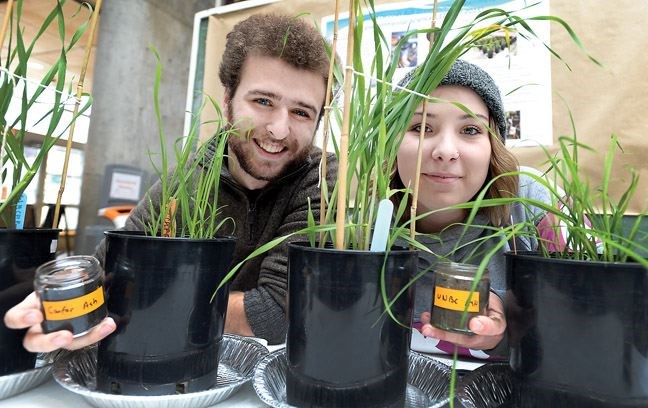University students showcased an ongoing project Wednesday that seeks to re-use waste ash from bioenergy plants in the community and on campus.
UNBC environmental science students Graham Thornton and Ashli Oe sat in front of potted plants of barley and orchard grass as part of the university's National Bioenergy Day showcase.
The plants are part of a two-month experiment, where the class tests the effects of ash in soil.
"We're using two different kinds of ash from the Canfor boiler and the UNBC bioenergy plant," Thornton explained from the Canfor Winter Garden. "It means we can use our waste ash as a fertilizer instead of just throwing it out."
"We're testing how well it works as a fertilizer," said Thornton, 20, adding they haven't yet done any testing, but it seems "the ash does affect the growth."
Environmental science professor Michael Rutherford said using the ash is a more sustainable approach to bioenergy. UNBC's plant produces some 80 to 100 tons of ash per year that simply goes to the landfill.
And that's a shame, Rutherford said.
"The wood, which is burned, came from the forest and many of the nutrients that were taken out by the tree in the forest end up in the ash. So if we landfill that ash, we're removing some of the plant nutrients from the biosphere," he said. "We're preventing them from being recycled."
This approach also leads to less reliance on fertilizers, which Rutherford notes need fossil fuels to produce.
"It's all tied together," said Rutherford, adding the ash meets the provincial metal requirements in order to use, but will have to pass a longer process if the university wants to meet federal certification to be named a fertilizer.
"Our goals are multifold. They include research with students on campus but we're also interested in operational scale in the sense that we would like to make the ash available once it's certified to local farmers or nurseries as well."
The goal of UNBC's Bioenergy Day was to showcase some of its sustainability efforts, said David Claus, assistant director of facilities.
In the latest move, the university has put pipes in the ground connecting its wood pellet boiler in a bid to replace some of its heating by natural gas.
"It's a new hot water piping loop to take heat from the existing wood systems and extend the distribution to the student residence buildings and the daycare," said Claus, adding it will mainly affect the hallways and showers, while the rooms still use electric heat.
Claus estimated it could mean a savings between $25,000 and $75,000. Yet another student project is looking to increase the efficiency of the existing system so they don't have to bring in additional wood.
Cost savings is one of the big reasons bioenergy can be a smart solution for businesses and communities, Claus said, who also highlighted its benefit over fossil fuels.
"At least if you're burning wood, you're part of the shorter term carbon cycle," he said, adding it can also benefit local economies.
"If you're buying wood, the wood comes from the local region and so your energy dollars are staying local. Whereas if you're buying electricity or you're buying natural gas, those energy dollars are spread over a much larger area."
Both Rutherford's students found the experiment a valuable experience for a first-year course.
"This is super important for first years just to get exposed to the type of process involved in scientific research," Thornton said. "For environmental science, there's a lot of bioenergy in B.C. so this is a good way to see what we can do with the waste."
Added Oe: "This gives you a really straight forward, hands-on approach to the kinds of things you might be doing later on in your career."



